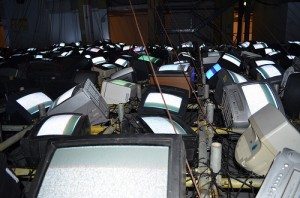 Local television news can be so easy to mock. Happy-talk anchors, meaningless live shots and enough on-screen grammar goofs to send an English teacher into orbit. The good news is that it’s not all terrible. But a lot of it is and, sadly, there’s not much hope for improvement.
Local television news can be so easy to mock. Happy-talk anchors, meaningless live shots and enough on-screen grammar goofs to send an English teacher into orbit. The good news is that it’s not all terrible. But a lot of it is and, sadly, there’s not much hope for improvement.
Take the fact that so many local newscasts look and sound alike. Not just a lot alike. Exactly alike. TBS late-show host Conan O’Brien has been having a field day lately making fun of TV stations for the sameness of their news programs by stringing video clips together. There’s nothing inherently funny about an anchor introducing a story about a new software program by asking, “Could this be the end of e-mail overload?” But it’s hilarious to watch 28 straight-faced anchors in row deliver the identical line.
How does this happen? Let’s start with the syndicated stories TV networks pump out to their affiliates, a service they’ve provided for decades. One of my first jobs in television many years ago was to log the video offerings from ABC on the cutely named DEF or “daily electronic feed.” What’s different now is that so many more stations both receive and use the stories from such feeds.
The big four broadcast networks, ABC, CBS, Fox and NBC, have around 200 affiliates each, but they’re pikers compared to CNN’s Newsource, which goes out to more than 800 stations across the country. That wide distribution practically guarantees a story will get decent play. The Newsource story about e-mail aired on at least 225 stations, according to Matthew Koll, chairman of the software company that was featured.
Like the networks, CNN makes it easy for local stations to run these stories by providing scripted introductions for local anchors to read. And read them they do, even when they don’t make much sense.
“The final days of a campaign can get a little salty,” parroted one anchor after another in November, whatever that was supposed to mean. The line provided by Newsource set up a story about election-themed drinks and food, and it earned a dozen local anchors a starring role in another Conan montage.
The widespread availability of these stories only partly explains why they’re so often used. Back in the day, fluffy features from the networks usually made air only when a local story ran late or fell through. Today, syndicated fodder is a necessity rather than a fallback, given the huge amount of news time stations now have to fill.
The average TV station produces about five-and-a-half hours of news each weekday, according to the most recent Hofstra/RTDNA survey of news directors. That’s an increase of almost an hour since 2008. Even as the economy tanked that year and stations cut their payrolls, they added more news time. While staffing has recovered, salaries have not. Average pay at local TV stations increased just 2 percent in 2011, failing to even keep up with inflation. “That’s likely the result of stations adding people who are mostly entry level–or at least paid at a noticeably lower rate than existing staff,” says Hofstra University’s Bob Papper.
Small wonder, then, that many stations literally rip and read the scripts that accompany the network feeds. Who has the time or experience to rewrite anchor introductions, much less produce original stories to fill all those newscasts?

Apparently, no one has time to proofread in some TV newsrooms either, so the graphics that make air can be real howlers. “Fire destroyed by home,” reported a Las Vegas station in a breaking news banner. An anchor in South Bend, Indiana, described the results of a national education survey next to a graphic that read, “School two easy for kids.” And in Tulsa, Oklahoma, one station warned viewers in a full-screen graphic in December to be careful driving on “snot and ice.”
Admittedly, it’s easy to poke fun at these sorts of flubs. And if you look in the right places, you can still find local stations producing great journalism. WVUE in New Orleans (Dirty Deeds and Hiding Behind the Badge), KLAS in Las Vegas (Desert Underwater, below) and WXYZ in Detroit (Wayne County Confidential) won prestigious duPont-Columbia awards this year for reports on significant issues ranging from government corruption to the housing crisis. KTRK in Houston earned the highest honor awarded by Investigative Reporters and Editors for exposing wrongdoing by local law enforcement officials (Constable Corruption).
http://youtu.be/kuhPSCZ57K8
But most television newsrooms aren’t doing in-depth reports or serious investigations on anything close to a regular basis. They can’t, as long as managers keep adding news time and expect the existing staff to fill it, while also feeding the Web and social media.
“Everyone is trying to do more with less,” says Micah Johnson, president of the talent agency MediaStars that represents TV news employees in contract negotiations. “I think it’s having a detrimental effect on the product.”
If the people who run some television stations were cooks, they could rightly be charged with watering the soup. And as long as stations keep following that recipe, local TV news will be an easy target for cheap fun.
Originally published by American Journalism Review









4 Comments
On the flip side….Companies like Scripps and the NBC O&O group have invested millions of dollars to build out special project and investigative units at all of their local stations. There are certainly problems with the entire news industry. Revenues have been flat to down for years while costs have gone up. At the same time distribution and consumption has become increasingly fragmented. However, there are more great investigations being done at the local level then I can remember. Some of the work being done right now is the best I have seen. It may not be in every show every night but it is out there. Access to different points of view and opinions has never been easier. News consumers are no longer passive watchers, they are active seekers of information. The quality is there but you have to seek it out…. it won’t come to you like it used to.
[…] Potter of TV NewsLab has posted an article that has some good points about TV news, but there’s one aspect of it that is off the […]